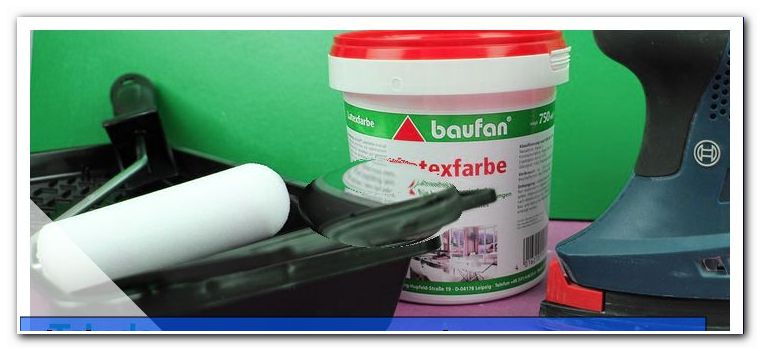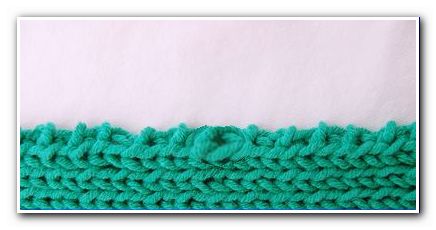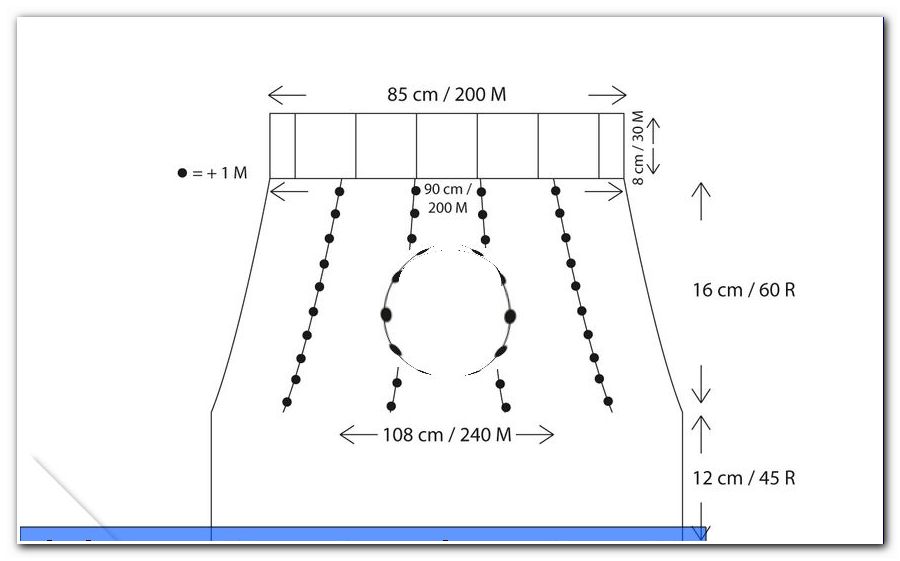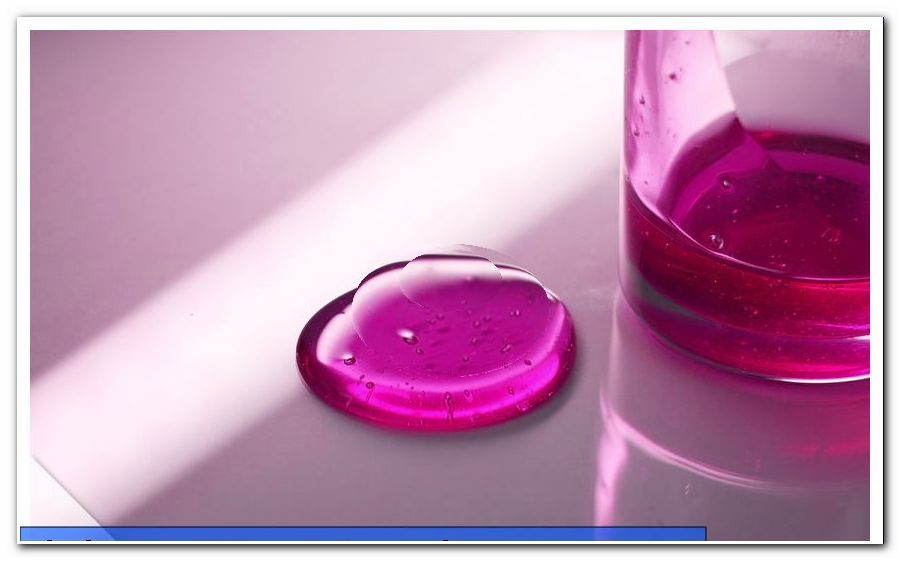Paint the latex paint and remove it from the wall

- Coat latex paint with emulsion paint
- The removal of latex paint
- Removal of the wallpaper with the wallpaper hedgehog
- Removal of the latex paint directly from the wall
If a new apartment is occupied or a renovation in the house, many builders are facing a problem called latex paint. What was often used with the good idea of protecting the walls from dirt can be a real problem when renovating. But a wall surface with this color is not lost, there are solutions for home improvement.
Overcoating or removing is possible
How you should treat a wall surface with latex paint is largely dependent on whether it is industrial or old colors or modern latex paints. In the past, the paint actually contained latex components, while today only a binder of synthetic resin was added to increase the gloss effect. While new latex paints can often be painted over, it is not possible with old colors and they must be removed. Conventional wallpaper solvers do not use much here because the paint is impermeable to water and does not react. With some tricks, the latex can still be removed from the wall.
Your shopping list, if you want to paint over the color:
- primer
- Brush for the corners
- Paint roller in two sizes
- telescopic handle
- grates
- cover
- masking tape
- Whisk / stir bar
To remove the latex paint, you will also need:
- Orbital sander (for paint directly on the plaster)
- Wallpaper hedgehog (in case of paint on wallpaper)
- Spray bottles with pumps
- Protective mask (breathing)
- possibly pickling agent
- Dish soap and water
- Cuttermesser
- hard brush
- Upholsterer brush
 Coat latex paint with emulsion paint
Coat latex paint with emulsion paint
First of all, you should know that old latex paints can not be painted over. The situation is different with the newer versions, which actually no longer contain latex, but instead are based on synthetic resin. Nevertheless, it is also difficult here, with more than two layers of latex, an overprint is no longer recommended. If you want to re-apply latex-based paint, no special care is required. Not even a primer is necessary. However, if you have decided to cover your previous latex wall with dispersion paint, you have to do some preliminary work.
Attention: A glossy latex wall can not be covered with a matt dispersion paint. The emulsion paint would not adhere and there would be a massive blistering.
The preparation
Before you can start painting, you should cover the room carefully. Be sure to also carefully cover the light switches, sockets, and strips with painter's tape and foil. Once these steps have been completed, inspection of the walls to be treated is essential. If there are holes or cracks, they must first be filled with putty. Only after all visible damage has been repaired, you can start with the primer.

The primer
Since latex paints are water repellent, other paints are difficult to adhere to, and so is emulsion paint. However, to achieve a visually acceptable result, a primer is necessary. Before applying it, you should carefully roughen the walls. This requires either an orbital sander or sandpaper. With the orbital sander, even large surfaces can be easily roughened; sandpaper requires a lot of physical effort before the wall is rough enough to hold the dispersion paint . For large wall surfaces should always be checked whether a removal of the wallpaper / color makes no sense.

Stir the primer according to the manufacturer's instructions and make sure that the primer contains no lumps. Carefully apply the first coat with a paint roller. Start at the area to the right of the door and work your way clockwise through the room. Finally, cover the ceiling with primer, although here should be a new coat of paint. Let the primer dry for at least six hours. This time may vary depending on the manufacturer. Only after the primer has completely dried, you can start with the actual painting.
The main painting
Check the result of the primer with your hands. If the surface feels rough, you can start applying the actual coating. If, however, the wallpaper peels or cracks and bubbles are visible, the painting is unnecessary, the wallpaper must then be removed. If the surface is not damaged, you can open the paint bucket and thoroughly stir the emulsion paint with a whisk. A wooden spoon is also suitable if it is a small bucket.
Tip: stirring whisk can also be put on the drill, so stir up viscous dispersion paint easily.
If you want to tint the emulsion paint, carefully mix the tinting ink and mix well. Otherwise, you can start directly with the painting. First use the brush and paint the corners with a thin layer of paint. Also around the sockets and light switch must be worked with the brush. The same applies to the transitions between walls and ceiling and in the area of skirting boards. When all corners have been painted, the paint roller is used. When coating latex paints, please note that the emulsion paint should be applied thinly and in several coats.

This time you start the painting on the ceiling, so that later no dripping paint on the painted walls when you paint the ceiling. After the ceiling has received the first coat of paint, work side by side through the room. Work with brisk movements and paint the color in the cross stroke . If a uniform, first coat is applied to the walls, a drying time of at least 12 hours is required. Only then can the second coat of paint be applied.
between control
After the first coat of dispersion paint has dried, you need to check the condition of the wallpaper. If it no longer adheres properly or if bubbles are visible, as well as cracks, break off the paint and remove the wallpaper. If, on the other hand, no signs of damage are visible, you can continue to paint after observing the drying time.
The second coat
At least two coats are required if you want to coat latex paints with dispersion paint. In individual cases, however, it may happen that another passage is needed. This depends on the optical result. If the original color was very dark and should now be painted over with a bright product, a third and fourth pass are often required.
The removal of latex paint
If old, latex-containing paint has spread on the walls, you can not get around a distance. Basically, wallpaper should be removed, which were painted over more than once with modern latex paint. The removal can be done in different ways, the use of an electric orbital sander is often a huge relief. Which method you choose depends on several factors. If you want to free a large area of paint, you should not work without electrical equipment. However, if only single walls or small rooms are treated with latex paints, you can also use the soaking method.
Removal of the wallpaper with the wallpaper hedgehog
A very useful tool in the removal of wallpaper that has been treated with latex paints is the so-called wallpaper hedgehog, also called spiked roller. This can be used to perforate existing wallpaper, so that water and wallpaper remover can be better absorbed. Latex paint has the property that it does not penetrate water. Thus, a normal soak the wallpaper is not possible if they are afflicted with this color.

If you have decided to remove it with a spiked roller, you should first cover the floors thoroughly. It is expected to be very dirty, so you should wear old clothes and a respirator. First, scratch the wallpaper several times in a cross shape with the utility knife. But do not cut too deep so that no visible joints remain in the substrate. Now put the wallpaper hedgehog on the wall and pull it with strong pressure from top to bottom. Start at the left side of the wall and work your way through to the other side. The wallpaper does not detach from the walls by using the roller, but gets cracks that make the following steps easier.
Soak and peel off
After the wallpapers have been perforated, conventional removal methods are used. First, you must soak the wall carefully. For this purpose, detergent lye with warm water is suitable. You can also resort to a mordant if the wallpaper is very stubborn and can not be detached from the wall. When using pickling agent, however, please note that you absolutely must wear respiratory protection. The water is sprayed onto the walls by means of a spray bottle. Here you must not save, there is an enormous need for fluids, so the wallpapers are really soaked. Calculate per wall with a fluid requirement of about four liters.
Tip: If you fill several spray bottles with detergent soap, you do not have to interrupt work.
Allow the moisture to penetrate for about 15 minutes and then begin to scrape off the wallpaper with the spatula. The workload is very high with this manual method, but the better the wallpaper is soaked, the better it can be loosened. If the color-covered wallpaper can not be solved, you have to use a paste brush to bring more water onto the walls. Do not save on moisture and scratch the wallpaper again with the craft knife, if there are no results.
Removal of the latex paint directly from the wall
If latex paints were painted directly on the wall, the distance is a bit more complicated, but still feasible. In this case, it is critically important how thick the ink layer is. For a very thin coat of paint, you can soak it with mordant and then scrape it off with a brush. You can also take alcohol for soaking, here the smell is more unpleasant, the risk of skin irritation but not too high. When using mordants and alcohol, it is imperative that you wear gloves and a breathing mask.

With thicker layers of paint, it is no longer done with solvents, here then the orbital sander must be used. With this it is quite easily possible to grind the paint from the wall. Always start work on one side of the wall and then work your way to the other side. The orbital sander should be seduced by a dust system, so that the resulting dust is filtered immediately and does not pollute your health. Alternatively, you can use a belt sander, but here you should do the sanding in two steps. The first sanding is then done with a coarse-grained paper, the second pass with a fine-grained paper.

If only small wall surfaces need to be cleared of paint, you can also use commercially available sandpaper. Start with a coarse-grained paper and then go over the surface again with fine-grained sandpaper. Since this variant is very labor-intensive, you can sand off the surfaces to be processed on several days in succession.
Tips for quick readers:
- Overprint only of new latex paint possible
- Priming before emulsion paint necessary
- Check wall for damage and repair
- Stir the primer and apply quickly
- Minimum drying time six hours
- Apply the dispersion paint in two steps
- Always keep paint layers thin
- If the starting color is dark, several coats are necessary
- Use roller to remove the wallpaper
- Carve the wallpaper and pull the roller over it
- Soak walls with rinse water
- Treat problem walls with pickling agent
- Remove wallpaper residues with spatula
- Sand the paint with an orbital sander
- Simply clean small surfaces with sandpaper


 Coat latex paint with emulsion paint
Coat latex paint with emulsion paint 

